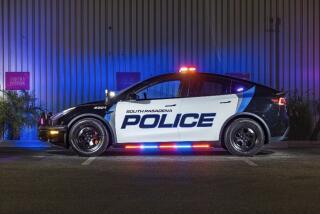German Experiment Tests the Mettle of Electric Cars : Technology: A $25-million Baltic Sea island project has put 60 of the vehicles on the streets to track their usefulness in everyday use, with everyday drivers.
- Share via
RUEGEN, Germany — Just a few years ago, Manfred Bartel was living in an automotive Ice Age.
Like most drivers in Communist East Germany, he counted himself lucky to even have a car. The average wait was 18 years for an expensive little two-cylinder Trabant that crumpled in most accidents, had the zip of a rusty lawn mower and continuously belched filthy pollutants into the environment.
Now, German unification and a California law he never heard of have brought cutting-edge technology to this tranquil Baltic Sea island. And much to his surprise, Bartel is quite literally in the driver’s seat.
The 50ish owner of a small used car lot and taxi fleet is part of a German experiment to test electric automobiles in everyday use, with everyday drivers.
Funded by the national government and German industry, the $25-million Ruegen project will run four years and put 60 electric cars, vans and buses on the streets of a dozen villages.
Volunteers spend six months driving the battery-powered vehicles, maintaining careful performance logs to supplement the wealth of data recorded by electronic equipment stashed in the trunk.
Three different batteries are being tested in Ruegen, and prototype “filling stations” are being built so the “Elektro” fleet can pull up and plug in.
Overseen by the Deutsche Automobilgesellschaft (DAUG), a daughter company of Daimler and Volkswagen, the Ruegen project began in October and now has eight electric vehicles in service. (Another two have been sidelined for safety concerns after the batteries they were supposed to test exploded during laboratory experiments.)
“We want to test electric vehicles in everyday use,” said project supervisor Uwe Braitling. “We need to find out which batteries (go best) with which engines in which cars for which purpose.”
Bartel has put nearly 2,000 miles on his Kelly green Mercedes 190 since DAUG delivered it shortly before Christmas, and he considers himself an electro-enthusiast. He compares the car positively to the gas-burning Mercedes he had driven for the past three years.
“It’s got a more pleasant feel to it,” Bartel said. “It just glides over the bad streets we have up here. And last winter, I had the least problems I’ve ever had with any car. You just get in and go.”
When he saw the newspaper ad looking for volunteer test drivers, Bartel immediately applied, dreaming of eventually owning a fleet of electric taxis that would prove economical and environmentally friendly.
“I’ve had to put aside that illusion,” Bartel admitted.
Short cruising distances and long recharging times make electric cars unrealistic, he said. Despite a project advertisement on the back windows boasting that “this car can reach distances of 109 miles,” Bartel reports an average of only 22 miles between charges.
Braitling also scoffs at the 109-mile claim, blaming it on fierce competition within the industry, with “no one wanting to say how little they have.” A spokesman at Daimler-Benz said the nickel-cadmium battery in the 190 could run for “50 miles maximum in city traffic.”
Recharging the car takes five to six hours, and the drivers are encouraged to run the battery completely down every day and fully recharge it. A small screen in the glove compartment tells drivers how much battery capacity they have left, in percentages. A reserve “tank” usually allows an extra half-mile to mile for the mathematically impaired.
Although a few customers at Bartel’s used car lot have inquired about buying an electric car like the green Mercedes, the Ruegen project has attracted little public notice on the slow-moving island. The electric cars’ speed limitations--the Mercedes can hit 74 m.p.h.--do not raise the ire they might elsewhere in Germany because Ruegen has no high-speed autobahn.
The 60 electric vehicles will be assigned mostly to public and nonprofit organizations, with the post office, national park rangers and health resorts on the list.
Because Ruegen is an island, distances are short and contained, and the terrain is relatively flat. Sunshine and windy weather make it ideal for using solar and wind power to generate electricity for some of the cars. The fragile coastal environment makes Ruegen an ideal candidate for an emissions-free future.
Although the experiment was given “a shove” by California’s electric vehicle requirements, the Bonn government said in a 1992 report that a California-style quota “is not foreseen” for Germany.
As he plugs in his bright green Mercedes for the night, though, Bartel reflects on his Trabant days and takes a more philosophical view.
“You just gotta give the things a chance,” he says.
More to Read
Sign up for Essential California
The most important California stories and recommendations in your inbox every morning.
You may occasionally receive promotional content from the Los Angeles Times.











